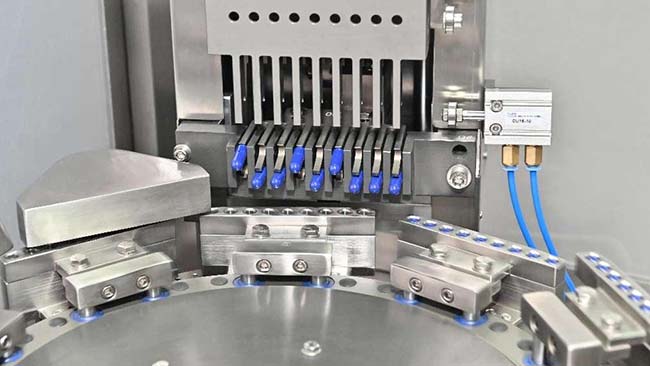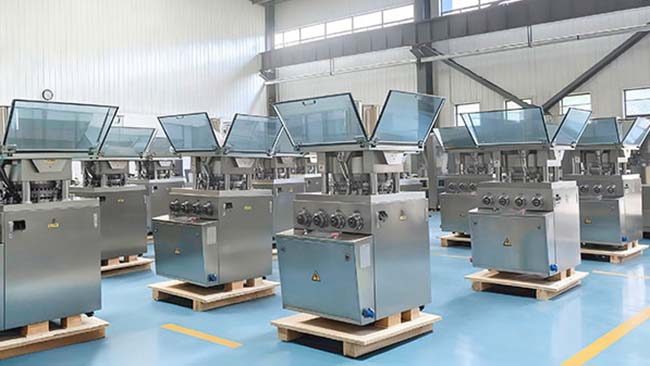Las cápsulas son una forma farmacéutica ampliamente utilizada en las industrias farmacéutica y nutracéutica, que ofrece una dosificación precisa, facilidad de manejo y un mejor cumplimiento terapéutico por parte del paciente. El llenado de cápsulas con polvo requiere precisión, eficiencia y cumplimiento de las buenas prácticas de fabricación, tanto en la producción a gran escala como en la preparación de lotes pequeños.
Cómo dispensar polvo en cápsulas? Cómo llenar cápsulas ¿En producción en masa? Los métodos empleados varían significativamente según el volumen de producción, el presupuesto y el uso previsto, desde máquinas de llenado de cápsulas totalmente automáticas hasta técnicas de llenado manual.
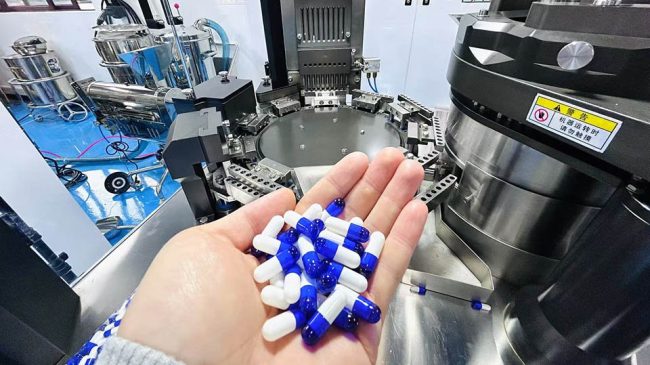
Las grandes compañías farmacéuticas suelen recurrir a encapsuladoras totalmente automáticas de alta velocidad que pueden producir cientos de miles de cápsulas en una hora. Estas máquinas, como la serie GKF de Bosch o la de Ruida Packing, Modelos de llenado de cápsulas NJP-5500DIntegran la dosificación precisa de polvos, la clasificación de cápsulas, el llenado y el sellado en un único proceso optimizado. Son ideales para la producción en masa de medicamentos comerciales, donde la consistencia, la velocidad y el cumplimiento normativo son cruciales.
Por otro lado, las máquinas llenadoras de cápsulas semiautomáticas, con capacidades que van desde unos pocos miles hasta decenas de miles de cápsulas/hora, sirven como una solución intermedia para fabricantes de tamaño mediano o farmacias especializadas que requieren flexibilidad sin una automatización total.
Por otro lado, los pequeños productores, farmacéuticos especializados en fórmulas magistrales y aficionados a la fabricación casera prefieren las máquinas llenadoras de cápsulas manuales o incluso las herramientas de llenado de cápsulas portátiles. Estos métodos son rentables y permiten la personalización de formulaciones, ideales para ensayos clínicos y medicina personalizada con bajos requisitos de producción.
1. Cómo Dispensar polvo en cápsulas mediante A nosotrosen un Semi–Llenado automático de cápsulaseh?
Una llenadora de cápsulas semiautomática es un dispositivo versátil diseñado para fabricar cápsulas vacías rellenas con ingredientes como polvos, gránulos o pellets. Combina operaciones manuales y automatizadas, lo que la hace ideal para producciones de mediana escala. CGNT-209 El modelo , por ejemplo, es una popular máquina de cápsulas semiautomática que garantiza la precisión en el llenado. A continuación, se muestra una guía sobre su funcionamiento.
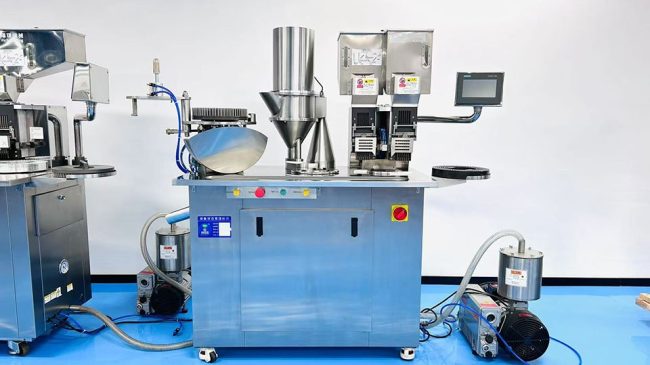
una máquina llenadora de cápsulas semiautomática
Paso 1: Materiales de alimentación
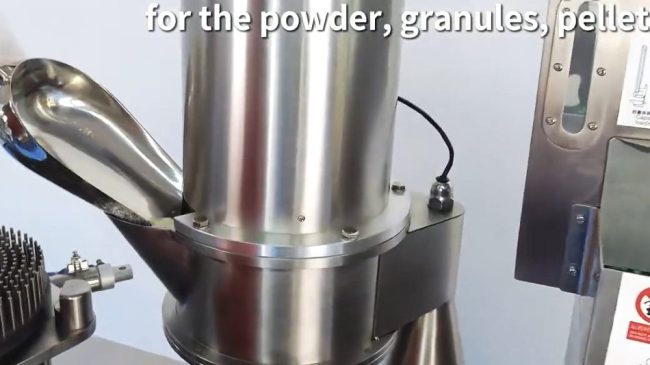
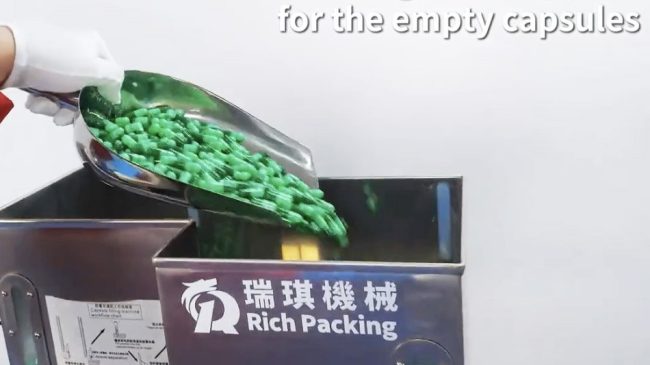
Primero, vierta las cápsulas vacías en la tolva de alimentación de cápsulas y el polvo medicinal (o gránulos/pellets) en la tolva de alimentación de medicamentos. La máquina separará y alineará las cápsulas para su posterior procesamiento.
Paso 2: Instalación de la bandeja de llenado de cápsulas
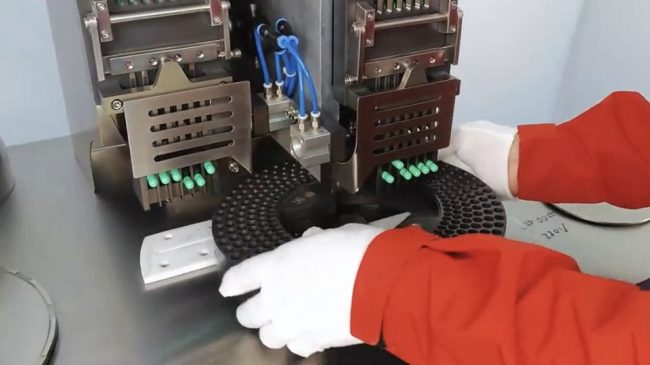
Las cápsulas vacías se transfieren mediante tubos dispensadores a bandejas de llenado. Una vez llenas, las bandejas giran automáticamente para asegurar la correcta separación de las cápsulas, separando los cuerpos de las tapas.
Paso 3: Llenado de cápsulas
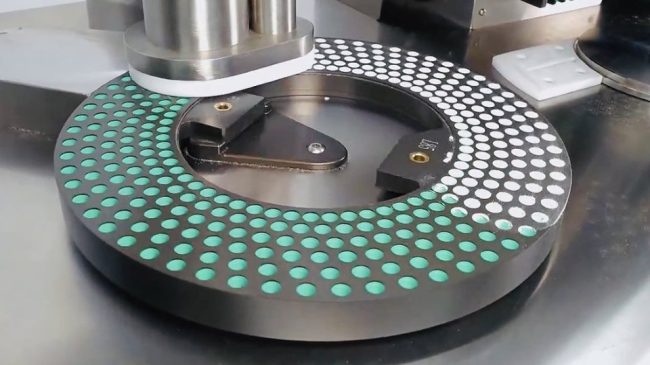
Trasladar las bandejas de llenado de cápsulas a la estación de llenado. El equipo separa las bandejas superior e inferior, dejando expuestas las cápsulas para el llenado de ingredientes. El polvo se dosifica automáticamente en las cápsulas.
Paso 4: Compresión del polvo (opcional)
Para una mejor densidad del polvo, coloque una placa de compresión (placa de apisonamiento) con pasadores de compresión sobre las cápsulas llenas. Presione la placa para compactar el polvo y repita el proceso de llenado para asegurar una dosificación precisa.
Paso 5: Bloqueo de la cápsula
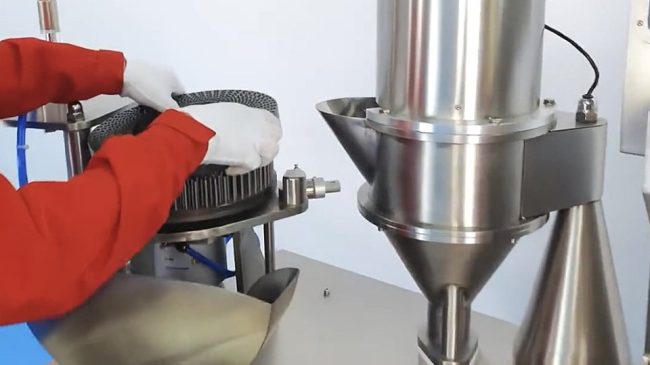
Transfiera las bandejas de cápsulas a la estación de bloqueo de cápsulas. Presione el botón de inicio y la llenadora semiautomática de cápsulas volverá a unir automáticamente las tapas de las cápsulas con los cuerpos de las cápsulas, bloqueándolos firmemente.
Paso 6: Recolección de cápsulas terminadas
Una vez que las cápsulas están bloqueadas, la máquina llenadora de cápsulas arrojará las cápsulas llenas a un contenedor de recolección, listas para su envasado o procesamiento posterior.
En comparación con una encapsuladora manual, la encapsuladora semiautomática CGNT-209 simplifica el proceso de encapsulación. Siguiendo estos pasos (alimentación de material, separación, llenado, compresión (si es necesario), cierre y recolección), los usuarios pueden producir cápsulas uniformes de forma más cómoda con mínima intervención manual. Esta máquina es ideal para farmacias, laboratorios y pequeños fabricantes.
2. Cómo Dispensar polvo en cápsulas mediante A nosotrosen un llenado de cápsulas totalmente automáticoen ¿Máquina?
Las máquinas de llenado de cápsulas totalmente automáticas son equipos farmacéuticos diseñados para la encapsulación rápida, precisa y eficiente de polvos, gránulos o pellets en cápsulas de gelatina dura o vegetarianas. Estas máquinas para fabricar cápsulas mejoran significativamente la eficiencia de la producción, garantizando la precisión de la dosificación y minimizando el riesgo de contaminación.
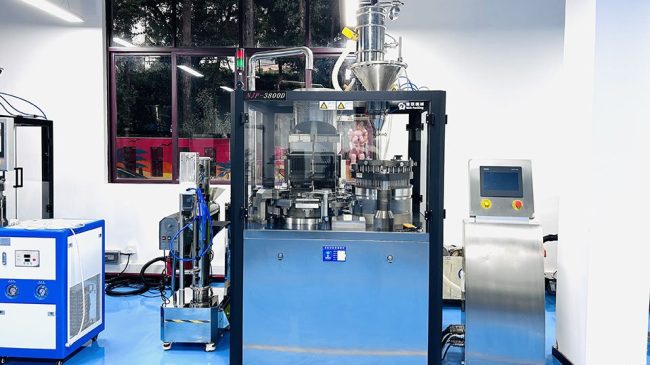
La máquina llenadora de cápsulas completamente automática NJP-3800D
2.1 ¿Qué tan alta es la producción?
Toma el NJP-3800D El modelo NJP-3800D, por ejemplo, ofrece una impresionante capacidad de llenado de 228 000 cápsulas por hora, lo que la hace ideal para la fabricación farmacéutica a gran escala. Además de su alta productividad, junto con sus modelos premium, la máquina llenadora automática de cápsulas NJP-3800D incorpora tecnologías avanzadas, entre ellas:
- Sistema de alimentación neumática Para una alimentación y transferencia suave de material.
- Diseño modular para el cambio de componentes y un mantenimiento cómodo.
- Construcción a prueba de polvo del plato giratorio, evitando la contaminación cruzada.
- Cabezal de indexación óptica ayuda a los divisores a garantizar que la variación del peso del llenado se mantenga por debajo de 3%, garantizando la consistencia de la dosis.
2.2 ¿Cuáles son las ventajas sobre las máquinas de cápsulas semiautomáticas?
En comparación con una máquina llenadora de cápsulas semiautomática, una máquina llenadora de cápsulas completamente automática ofrece ventajas significativas:
- Mayor capacidad de producción:llenando miles o cientos de miles de cápsulas más por hora.
- Reducción de la dependencia laboral:operación totalmente automatizada.
- Precisión mejorada: menor desviación del peso de llenado.
- Higiene mejorada:Los sistemas cerrados minimizan la contaminación del material.
- METROmás confiablecalificación de productos terminados: rechazo automático de cápsulas defectuosas.
2.3 Pasos operativos de una máquina llenadora de cápsulas automática
Paso 1: Carga de materiales
Las cápsulas vacías se vierten en la tolva de alimentación, mientras que el polvo, los gránulos o los pellets medicinales se cargan en la tolva de llenado. Para mayor comodidad, se pueden utilizar cargadores automáticos de cápsulas y alimentadores de polvo al vacío para automatizar este proceso, minimizando así la operación manual.
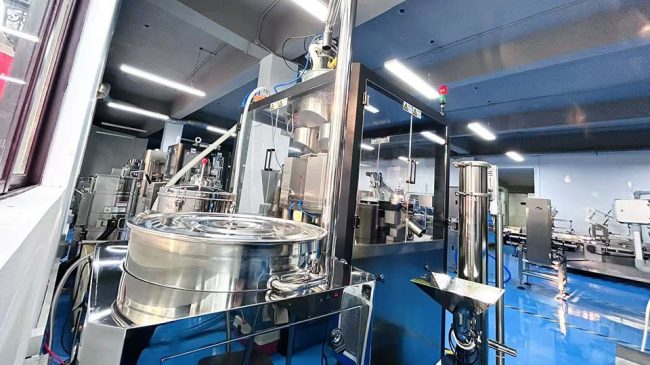
Un cargador automático de cápsulas junto con una máquina llenadora automática de cápsulas
Paso 2: Configuración de parámetros

Los operadores pueden configurar la máquina para fabricar cápsulas a través de una pantalla táctil PLC, ajustando parámetros como el peso de llenado, el tamaño de la cápsula y la velocidad de producción para cumplir con requisitos específicos.
Paso 3: Proceso de encapsulación automatizado
La máquina de cápsulas ofrece un rendimiento totalmente automático durante todo el proceso sin intervención manual:
- miAlimentación con cápsulas vacías – separa y alinea las cápsulas vacías.
- Llenado de cápsulas – dosifica con precisión el ingrediente médico en los cuerpos de las cápsulas.
- Compresión de polvo – garantiza un llenado compacto.
- Bloqueo de cápsulas – une las tapas y los cuerpos de las cápsulas de forma segura.
- Rechazo de cápsula defectuosa – elimina las cápsulas que no están llenas correctamente.
- Descarga del producto terminado – produce cápsulas completadas para su posterior procesamiento.
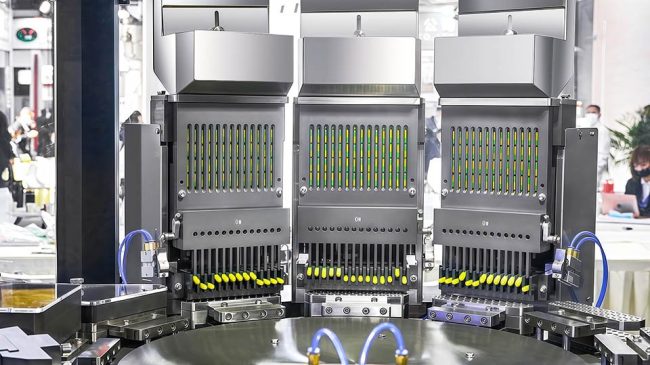
El mecanismo principal de una máquina para fabricar cápsulas totalmente automática.
Paso 4: Posprocesamiento opcional
Para preservar aún más la calidad de las cápsulas y la eficiencia del envasado, se pueden integrar las máquinas adicionales mencionadas a continuación con un máquina llenadora de cápsulas:
- Pulidor de cápsulas: elimina el posible polvo residual en las superficies de las cápsulas para una apariencia más limpia.
- Máquina de envasado en blíster – sella automáticamente las cápsulas en blísteres de aluminio-plástico o alu-alu para un embalaje a prueba de manipulaciones, listo para la venta minorista.
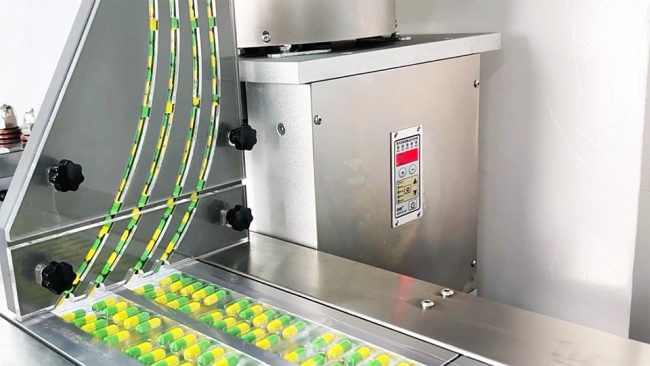
El mecanismo de alimentación de cápsulas de una máquina envasadora de blísteres.
- Máquina contadora de cápsulas — cuenta automáticamente las cápsulas en las botellas para un embotellado farmacéutico preciso, haciendo que cada botella contenga la misma cantidad de cápsulas.

El proceso de separación de cápsulas en una máquina contadora de cápsulas.
Al minimizar la intervención humana y maximizar la eficiencia, las máquinas de encapsulación automática garantizan una calidad de llenado constante al tiempo que reducen los costos operativos, lo que las hace indispensables en la fabricación de medicamentos modernos.
3. Cómo Rellene las cápsulas por Tútilización una cápsula manual Máquina?
Una encapsuladora manual es un dispositivo sencillo y manual, diseñado para llenar con precisión cápsulas vacías con medicamentos en polvo, suplementos o formulaciones herbales. A diferencia de las encapsuladoras automáticas, requiere esfuerzo manual, pero es rentable e ideal para la producción a pequeña escala, farmacias de formulación magistral o laboratorios.
Aunque una encapsuladora manual no es tan eficiente como las automáticas, es muy asequible y mucho más económica. Además, es portátil.
El llenado de cápsulas con una llenadora de cápsulas manual implica una guía sencilla, paso a paso:
Paso 1: Preparar las bases de las cápsulas
Comience colocando las cápsulas vacías en los orificios de la placa de alineación. Asegúrese de que cada cápsula esté bien colocada en posición vertical para evitar desalineaciones durante el llenado.
Paso 2: Dispensar el polvo uniformemente
Extraiga el medicamento en polvo y extiéndalo sobre el disco dosificador. Este disco ayuda a distribuir el polvo uniformemente en la base de cada cápsula, asegurando una dosificación uniforme en todas las cápsulas.
Paso 3: Compactar el polvo
Presione suavemente el polvo con el apisonador para comprimirlo. Repita el proceso, añadiendo más polvo según sea necesario, hasta que las cápsulas alcancen el nivel de llenado deseado. Un apisonamiento adecuado evita que se llenen demasiado o demasiado poco.
Paso 4: Sella las cápsulas
Coloque las tapas de las cápsulas sobre la placa de alineación, alineándolas con las bases llenas. Utilice la placa de tapado para presionar firmemente las tapas sobre las bases, asegurando un cierre seguro de las cápsulas.
Paso 5: Comprobación final y finalización
Una vez cerradas, retire las cápsulas de la placa e inspecciónelas. Verifique que cada cápsula esté correctamente cerrada y libre de polvo residual. Manual llenadora de cápsulasSon ideales para lotes de producción pequeños y ofrecen una consistencia confiable.
4. HCómo llenar las cápsulas en casa ¿Sin ninguna máquina?
A hacer tus propias cápsulas Llenar las cápsulas a mano es una forma práctica y económica de personalizar los suplementos dietéticos según tus necesidades. Con solo unas pocas herramientas básicas, como una báscula para medir con precisión los ingredientes de las cápsulas, una cuchara, un embudo y recipientes, puedes llenarlas fácilmente en casa. A continuación, te presentamos dos métodos sencillos para ayudarte a empezar.
4.1 Método 1: La técnica de la pala
Este enfoque es el más sencillo y requiere un equipo mínimo.
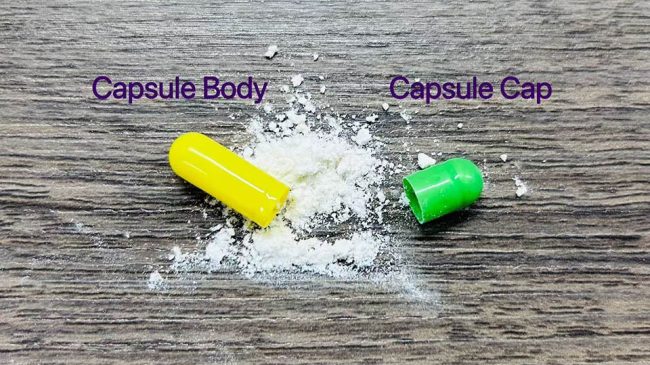
Paso 1: Preparar el polvo
Coloque el polvo o la mezcla de hierbas que desee sobre una superficie limpia y seca, como un plato poco profundo.
Paso 2: Separar la cápsula
Gire suavemente la cápsula vacía para dividirla en dos mitades: el cuerpo y la tapa.
Paso 3: Llene la cápsula
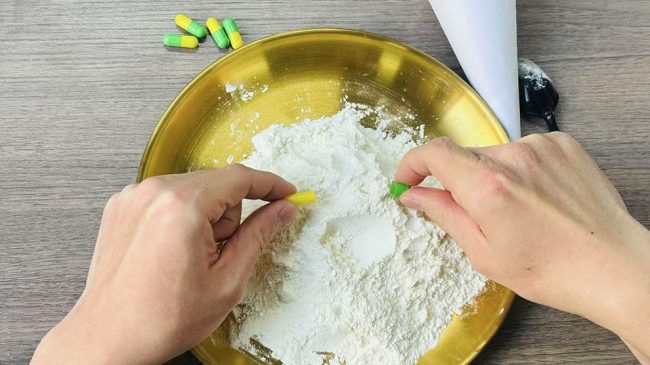
El cuerpo de la cápsula debe presionarse hasta el polvo, utilizando un movimiento de cuchara para compactarlo completamente. Evite llenar demasiado la tapa para facilitar el sellado.
Paso 4: Sella la cápsula
Alinee el cuerpo lleno con su tapa y presiónelos firmemente pero con cuidado para asegurar la cápsula.
Este método es rápido y sencillo, ideal para quienes prefieren herramientas mínimas.
4.2 Método 2: El método de la cuchara y el embudo
Para una dosificación más precisa, esta técnica incorpora una cuchara y un embudo improvisado o real.
Paso 1: Preparar el polvo
Distribuye el polvo elegido uniformemente sobre un plato limpio y seco.
Paso 2: Separar la cápsula
Separar la cápsula en sus dos mitades como antes.
Paso 3: Crea un embudo
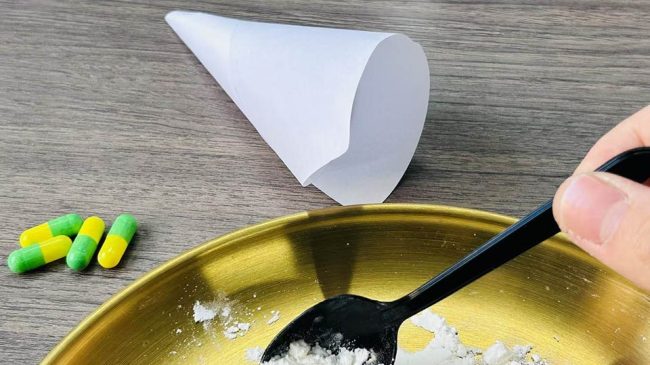
Si no tienes un embudo, enrolla un trozo de papel en forma de cono, dejando una pequeña abertura en la parte inferior.
Paso 4: Llene la cápsula
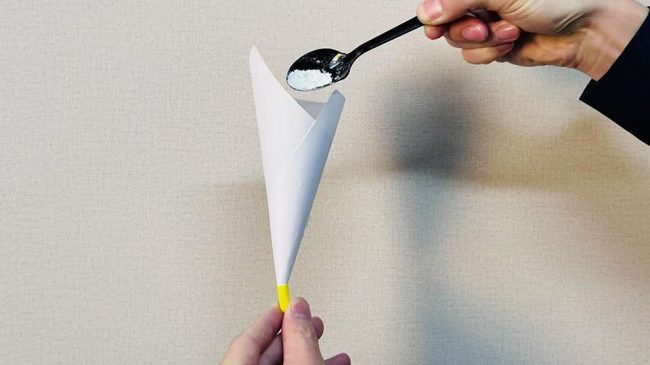
Inserte el extremo estrecho del embudo en el cuerpo de la cápsula. Con una cuchara, transfiera con cuidado el polvo al embudo, dejando que llene la cápsula. Repita este procedimiento con la tapa si es necesario. Para mayor precisión, pese el polvo previamente con una báscula.
Paso 5: Sella la cápsula
Una vez lleno, unir ambas mitades y presionar ligeramente para cerrar la cápsula.
Siguiendo estos métodos, podrá preparar fácilmente cápsulas caseras a su gusto. Tanto si opta por la técnica de cuchara como por el método del embudo, ambos métodos garantizan un proceso sencillo. Guarde las cápsulas terminadas en recipientes herméticos para conservar su frescura.
Con un poco de práctica, llenar cápsulas a mano se convierte en una tarea sencilla, ofreciendo flexibilidad y control sobre la ingesta de suplementos.
5. ¿Qué? Debería Tú sabes más allá de la cápsula Relleno?
Llenar cápsulas de medicamentos implica más que simplemente operar un... máquina llenadora de cápsulasComprender el tamaño de las cápsulas y la elección de materiales es crucial para garantizar la precisión de la dosis, el cumplimiento del paciente y la estabilidad del producto.
5.1 Tamaños de cápsulas: cómo encontrar el tamaño adecuado
Los tamaños de cápsula varían en 8 tipos: el tamaño 000 indica el mayor y el tamaño 5 el menor. La capacidad de peso de una cápsula depende de la densidad del polvo.
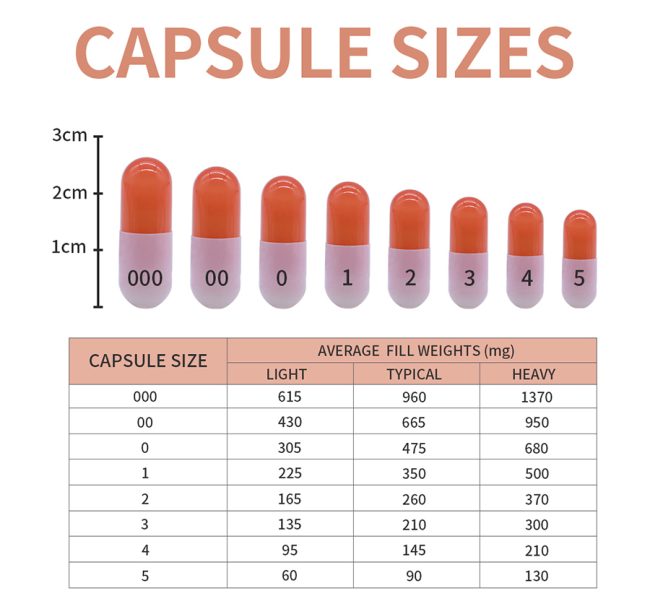
Las cápsulas de tamaño 000 contienen entre 700 y 1300 mg de un polvo ligero, mientras que las cápsulas de tamaño 5 contienen solo entre 60 y 130 mg.
Los tamaños más comunes son el 0 y el 1, ya que admiten dosis promedio con facilidad. Sin embargo, se prefieren cápsulas más grandes (p. ej., tamaño 000 o 00) para:
- Suplementos dietéticos de dosis altas (por ejemplo, aceite de pescado, mezclas de hierbas).
- Medicamentos veterinarios (los animales más grandes necesitan dosis más altas).
Por el contrario, las cápsulas más pequeñas (por ejemplo, tamaño 3 a 5) son ideales para:
- Medicamentos potentes (por ejemplo, hormonas, ciertos antibióticos).
- Pacientes pediátricos o de edad avanzada que tienen dificultad para tragar.
5.2 Cápsulas de gelatina vs. cápsulas vegetarianas: Diferencias clave
| Cápsulas de gelatina | Cápsulas vegetarianas (HPMC/Pullulan) |
Material | Derivado de colágeno animal (bovino/porcino) | Celulosa de origen vegetal (HPMC o pululano) |
Apariencia | Claro, brillante, suave. | Ligeramente opaco o mate |
Actuación | Se disuelve rápidamente (liberación rápida) | Disolución más lenta, resiste la reticulación. |
Duración | 2–3 años (mejor con baja humedad) | 2–3 años (más estable a la humedad) |
Desventajas | No es apto para vegetarianos; puede volverse quebradizo en condiciones secas. | Más caro; puede necesitar ajustes de la máquina. |
La elección del tamaño y el material de cápsula adecuados depende de la dosis, el público objetivo y las necesidades de estabilidad. Si bien las cápsulas de gelatina son económicas y de rápida disolución, las vegetarianas se adaptan a las preferencias éticas y dietéticas. Para obtener resultados óptimos, tenga siempre en cuenta estos factores junto con la configuración de la máquina de cápsulas.
Conclusión
Preparar tus propias cápsulas ofrece ventajas significativas, como ahorros en costos y la posibilidad de crear mezclas de suplementos personalizadas. Dominando el proceso y utilizando las herramientas adecuadas, puedes producir suplementos dietéticos personalizados de alta calidad, adaptados a tus necesidades específicas.
Para aquellos que buscan equipos profesionales para el llenado de cápsulas, Embalaje Ruida es un fabricante confiable de equipos farmacéuticos de máquinas de llenado de cápsulas de alta calidad. Su estricto control de calidad y cumplimiento de los estándares de la industria garantizan un rendimiento confiable para todas sus necesidades de producción de cápsulas.
